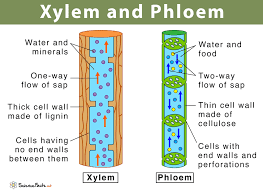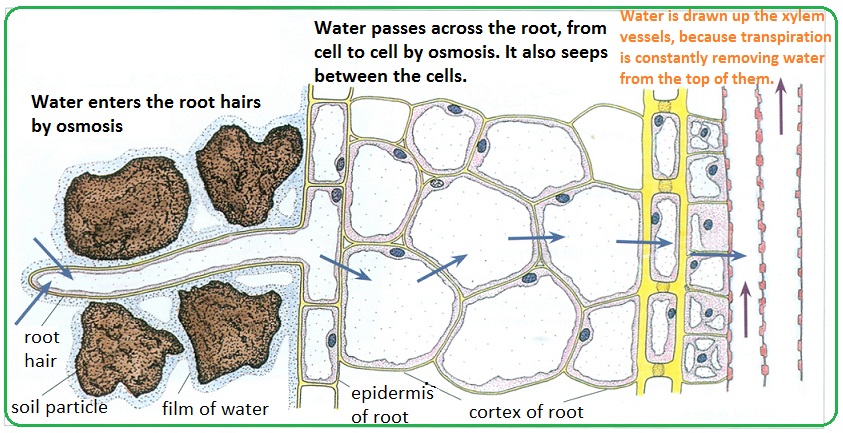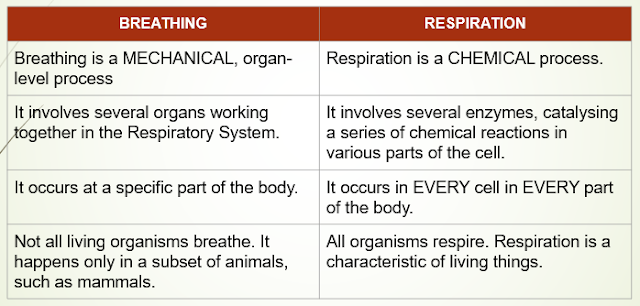PLANT TRANSPORT [CSEC BIOLOGY]
SYLLABUS REFERENCE
- [B4.7] explain how the structure of xylem vessels is suited for their function;
- [B4.8] discuss the role of the process of transpiration in plants;
- [B4.9] describe the effect of external factors in transpiration;
- [B4.11] explain how the structure of the phloem is suited to its functions;
PLANT TRANSPORT SYSTEMS IN OVERVIEW
Unlike animals, plant transport systems do NOT have:
- a pump
- a specialised transport medium.
It depends
on several passive physical processes & active transport, working together
to produce pressure differences between one end of the plant and another.
This
network of vessels for circulation is called a vascular system, also called a
vascular bundle. The vascular bundle is a long, continuous strand of tissue
that extends from the roots, through the stem to the leaves of plants.
What is
called a transport system in plants consists of a network of very fine tubes
made of specialized tissue known as xylem and phloem.
 |
XYLEM (TRANSPORTS WATER & MINERAL IONS)
This tissue is made of dead cells with lignin embedded in their walls.
- The cells are joined end-to-end, with the cross walls broken down between them to produce a long, hollow tube.
- The lignin strengthens cell walls & makes the vessels waterproof. It also allows the tube to give support, rigidity & strength to the plant stems.
- They are thin enough to allow movement of water via capillary action.
THE JOURNEY OF WATER FROM ROOTS TO LEAVES
Roots to Xylem Vessels
Root hair cell à Cortex (Parenchyma)
cells à Xylem vessels
It begins
with water uptake from the soil into the roots, via osmosis.
At the surface of the roots are multiple root hair cells, modified with elongated sections that extend into the surrounding soil. It is specialized for efficient water uptake from the surroundings.
Water that enters the root hair cell immediately moves from cell to cell to the xylem vessels, via diffusion & osmosis.
- The water moves from cytoplasm to cytoplasm via osmosis, across the cell membranes.
- The water moves through the cell walls via diffusion, up to the endodermis.
Up the Xylem Vessels, from
Soil to Leaves
Once in the
xylem vessels, water forms unbroken columns from the roots, up the stem, and
into the leaves. Capillarity helps to maintain the unbroken columns of
water.
Capillarity
is the spontaneous rise of water up a thin tube that was inserted into water. It
is caused by the forces of attraction between the molecules of water and the
tube’s walls, and between the water molecules themselves.
Being very
narrow, xylem vessels encourage capillarity.
Once in the
xylem vessels, water forms unbroken columns from the roots, up the stem, and
into the leaves. Capillarity helps to maintain the unbroken columns of
water.
Capillarity
is the spontaneous rise of water up a thin tube that was inserted into water. It
is caused by the forces of attraction between the molecules of water and the
tube’s walls, and between the water molecules themselves.
Being very
narrow, xylem vessels encourage capillarity.
Transpiration -
Evaporation of Water Out of the Leaves
Xylem à Spongy Mesophyll
Cells à Air spaces in Spongy
Mesophyll à Surrounding air
When the
water gets from the xylem to the leaves, it moves from the xylem to spongy
mesophyll cells via osmosis. Water evaporates off the surface of the spongy
mesophyll cells into the surrounding air spaces. From there, it diffuses out
the leaf, via the stomata.
The water lost via evaporation is replaced by water from the xylem. This puts a pulling force on the water column in the xylem vessels. This is called the transpiration pull.
Xylem à Spongy Mesophyll
Cells à Air spaces in Spongy
Mesophyll à Surrounding air
When the
water gets from the xylem to the leaves, it moves from the xylem to spongy
mesophyll cells via osmosis. Water evaporates off the surface of the spongy
mesophyll cells into the surrounding air spaces. From there, it diffuses out
the leaf, via the stomata.
The water lost via evaporation is replaced by water from the xylem. This puts a pulling force on the water column in the xylem vessels. This is called the transpiration pull.
FACTORS THAT AFFECT THE RATE OF TRANSPIRATION
Temperature
Increasing temperature increases the rate of evaporation from the leaves. This increases transpiration rate. Note, however, that if the temperature gets too high, the plant's leaves will partially close their stomata in order to conserve water. The transpiration rate thus decreases at that time. Humidity
Humidity
Wind Velocity
When the air is still, the water vapour that diffuses out the leaves build up around the stomata. This creates a humid environment that slows transpiration. Wind keeps the water vapour moving away from the stomata.
Therefore transpiration slows down as wind velocity slows down, and vice versa.
Light Intensity
PHLOEM (TRANSPORTS ORGANIC SUBSTANCES)
Phloem transports food materials, mostly in the form of sugars, from the leaves to all parts of the plant.
It consists of living cells: sieve tubes & companion cells.
Sieve cells are cylindrical and joined at their end walls to form strands called sieve tubes. The end walls are called sieve plates. They are called thus because it is pierced with small holes.
Companion cells are located next to each sieve plate.
The movement of sugars and other substances from one region to another through the sieve cells is called translocation.
Translocation
Sugar passes from leaf cells (called the Source) to sieve cells via active transport. The translocation of sugar depends on differences in sugar concentration in various parts of the plant (called the Sinks). At the sinks, sugar diffuses from the sieve cells to the nearby cells, such as at the roots.The sugar solution moves along the sieve tube due to pressure build up from addition of water from nearby xylem vessels.






